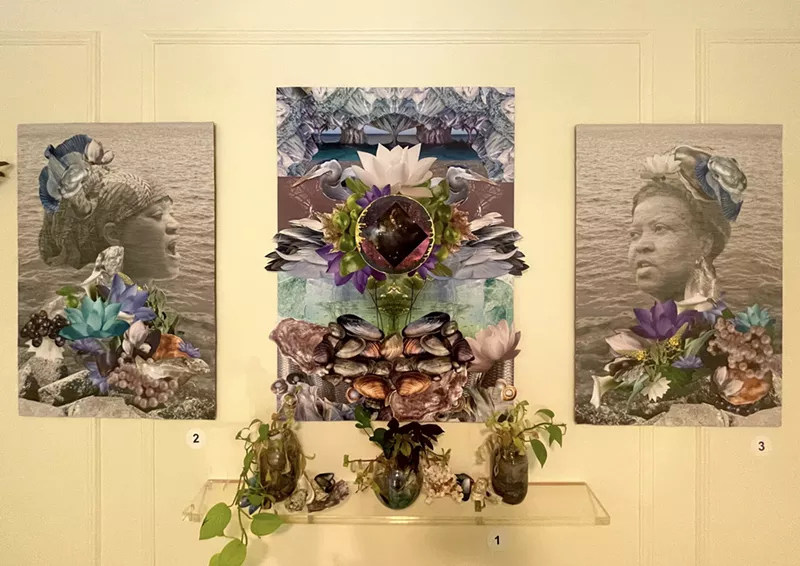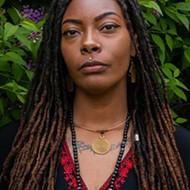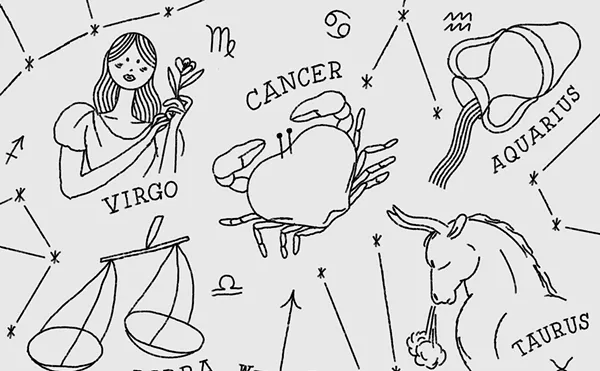These two Detroit artists are manifesting liberation from the climate crisis through collages
Kresge and Gilda Award winners Halima Afi Cassells and Shanna Merola have two exhibits up through September

Audio By Carbonatix
[
{
"name": "GPT - Leaderboard - Inline - Content",
"component": "35519556",
"insertPoint": "5th",
"startingPoint": "3",
"requiredCountToDisplay": "3",
"maxInsertions": 100,
"adList": [
{
"adPreset": "LeaderboardInline"
}
]
}
]

Plants and mushrooms are the ones that will purify the earth as human beings continue to fuck it up.
“Even where you have sites of ecological disaster all around Detroit, you have these mushrooms, mullein, milkweed, and plantain that show up to do the job of getting the earth back on track,” says artist Halima Afi Cassells. “It happens in our backyard, it happens in our driveways, and people are often taught these are weeds that need to be killed, but they’re superfoods that are helping us."
Cutouts of these plants and fungi sprout from behind the windows at Room Project, creeping toward altars of bullets, dried flowers, and other discarded objects in a collaboration between Cassells and Shanna Merola. Titled Swan Song, the installation combines collage and sculpture as it examines the havoc wreaked by colonialism and the climate crisis.
Swan Song debuted in the Museum of Contemporary Art Detroit’s Mike Kelley Mobile Homestead earlier this year and has now found a home in the New Center coworking space’s window.
Swans recur throughout the installation as a metaphor for status, perceived beauty, and a sweet song just before bursting into flames to re-emerge from the ashes like that annoying phoenix reference people keep making about Detroit. In Greek mythology, the mute swan is thought to sing a beautiful song right before it dies.
Apparently, swans are considered the “Queen’s Bird” and according to a centuries-old law, the current British monarch owns all the swans in England, too.
“It’s the most crazy conception of power and control. How do you think you own them?” Cassells says about the royal family’s weird swan rules. “Land ownership is just as bizarre. It was here way before us and it’ll be here way after. Then, the swan is seen as a creature of beauty, grace, aggression, and loyalty [because] they mate for life. So all of those contradictions are inside of one motif and the [King] of England owns it all.”
The tile is also a nod to Belle Isle’s original name, “Wahnabezee” or “Swan Island” as the Anishinaabe people called it pre-colonization.
“Halima and I have been working together for a few years now, collaborating on projects at the intersection of ecological crisis and disaster capitalism,” Merola says. “We are also interested in studying countries that have liberated themselves from colonial rule, and constitutions that have acknowledged the ‘rights of nature.’ In Swan Song, we wanted to highlight the conditions of neighborhoods living in the shadow of heavy industry while acknowledging the contributions of frontline communities to environmental justice movements.”
The pair plan for the exhibit to travel to different spots along the St. Lawrence Seaway, which was erected to allow ships to travel between the Atlantic Ocean and the Great Lakes. New York’s Love Canal, where chemical dumping led to mass contamination of the area’s soil and groundwater in the late 1970s, is among one of the seaway’s ports.
“So is Cleveland, Toledo, and Detroit,” Cassells adds. “If you look at Lake Erie, all the invasive algae and invasive mussels come from the Atlantic and all the ships. At one point they dug up the river around Belle Isle so that even larger ships with heavier loads can come through, distributing the spawning ground for sturgeon which have been in the Great Lakes for 150 million years. This is a total disregard for the natural environment just for the sake of more crap that most people don’t actually need that will end up in a landfill or incinerator.”
Water preservation is a huge theme in another collaborative exhibit by the two artists, Solvent, which is at The Gallery of Revolution in the James and Grace Lee Boggs Center. Solvent “invokes the world between memory, history, collective storytelling, and liberation at the water’s edge,” the exhibition statement reads.

Similarly to Swan Song, it incorporates foraged materials, rocks, shells, and photo collages made by the artists both individually and collectively. Lotus flowers, pearls, and mussels appear throughout the work. The centerpiece is a tribute to Detroit activists Lila Cabbil and Charity Hicks, who fought for low-income families getting their water shut off by the City of Detroit.
“Solvent is a play on words with being liquid and being able to move how you want to move,” Cassells says. “So many words that relate to water also deal with commerce and deal with these systems but how are we really protecting water and paying homage to those who do the work of protecting water?”
Swan Song and Solvent feel twofold. They’re both a critique and a homecoming to an ancestral relationship with the earth.
For exhibits that dredge up disdain for such depressing things as late-stage capitalism, the prioritization of corporations over people, and the destruction of our natural world, they’re uncannily beautiful. Tables decorated with golden ceramic swans and ornate dishes full of shells feel like an elaborate scene from the queen’s living room. Inside Room Project, a wicker chair (like the ones our fly aunties used to pose in) sits in front of a portal into another dimension where we can reunite with the stars.
As Cassells says, “It’s a throne that anybody can assume.”
Cassells is a 2023 Kresge Artist Fellow and Merola is a Gilda Snowden Emerging Artist awardee.
Where to see their work: Swan Song is up until Sept. 30 at Room Project; 6513 Woodward Ave., Detroit as part of the “Our Craft of Care” series curated by Cyrah Dardas. Though the space is not open to the public, the installation is mostly located in Room’s front window. A closing conversation is set for September 22 at 7 p.m.
Solvent is on display until Sept. 30 at The Gallery of Revolution inside the James and Grace Lee Boggs Center; 3061 Field St., Detroit. Hours are Monday and Wednesday through Saturday from 10 a.m.-2 p.m.
Subscribe to Metro Times newsletters.
Follow us: Google News | NewsBreak | Reddit | Instagram | Facebook | Twitter






